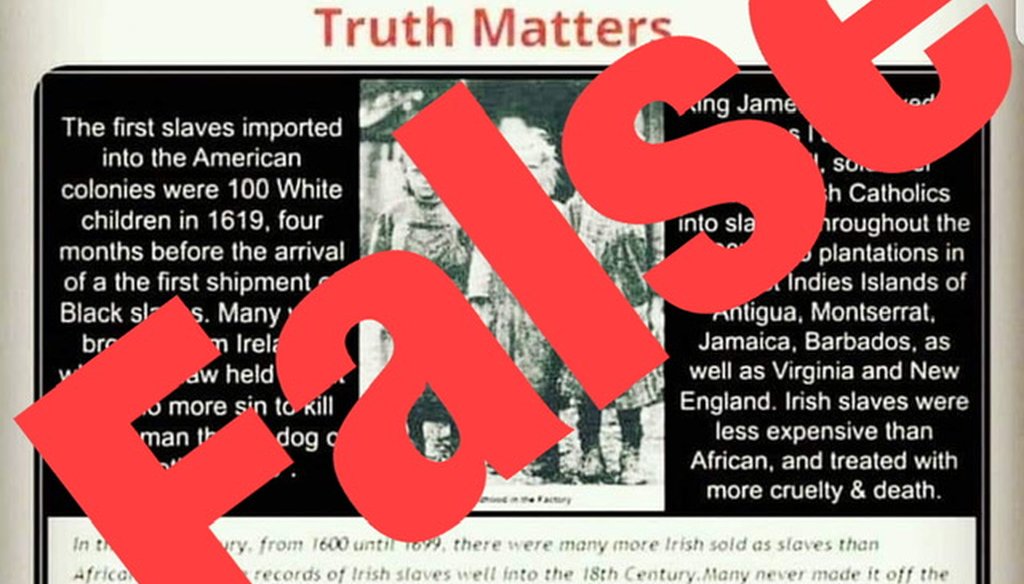

Our only agenda is to publish the truth so you can be an informed participant in democracy.
We need your help.


An image being shared on Facebook falsely claims that 100 white children from Ireland were “the first slaves shipped to the Americans Colonies in 1619.” Not only is the claim wrong, this image is actually a famous Lewis Hine photo taken in 1911.
The day after a congressional hearing to discuss legislation that would create a commission to study reparations for African Americans, an old claim about white, Irish slaves gained steam.
"The first slaves shipped to the Americans Colonies in 1619 were 100 white children from Ireland," reads the text of an image shared on Facebook on June 20. "Truth matters."
The post, which features a black-and-white photo of three children, adds that the Irish arrived in the colonies "four months before the arrival of a the (sic) first shipment of black slaves."
"White slavery," it says, "history denied, covered up, & marginalized."
This post was flagged as part of Facebook’s efforts to combat false news and misinformation on its News Feed. (Read more about our partnership with Facebook.)
That’s because it’s not true.
Leslie Harris, a history professor at Northwestern University, told PolitiFact the claim is "part of an attempt by several groups of people to claim that Irish people were enslaved in the Americas before and in excess of the numbers of people of African descent."
But Irish people were not enslaved in the Americas, she said, and people of African descent "far outnumbered European migrants to the Americas before the 19th century."
Harris directed us to Liam Hogan, a research librarian in Ireland who she described as the most knowledgeable source on claims of Irish slavery. Both Harris and Hogan are quoted in a 2017 New York Times story titled: "Debunking a myth: The Irish were not slaves, too."
As it turns out, Hogan also debunked this exact claim and image after actor James Woods shared it on his Twitter account on April 17.
Responding in a Twitter thread that very day, Hogan started with the photo, which he said is a famous Lewis Hine picture showing three child laborers at a canning company at Port Royal, South Carolina, in 1911. (The Library of Congress has a digital file of the photo here.)
In 1619, Hogan says in the thread, 100 "poor English children" between the ages of 8 and 16 were "taken from the streets of London and sent to Virginia and sold into indentured servitude. This was a radical extension of the English Poor Law of 1601."
Meanwhile, Hogan says in the thread, there were 1,301 slave trading voyages from 1514-1619 involving about 500,000 Africans.
"In reality," Hogan adds, "thousands of Irish people were sold as servants (most voluntarily) while (approximately) 1,900,000 Africans were shipped to the colonies as slaves (always involuntarily.)"
Hogan pointed us to another Twitter thread he wrote on the subject in November 2018. There, he explained more about the 100 English children sent to Virginia as part of the Poor Law that directed the children of paupers to work in the homes of other families as apprentices. Those that survived the journey to America, Hogan said, were to be apprentices for seven years.
Certainly, said Michael Guasco, a history professor at Davidson College, there was forced transportation and convict servitude in the American colonies.
"Certainly, things often did not work out well for people in these situations," he told us. "Certainly, there were conversations about the use of slavery as a form of criminal punishment in England and some of the colonies in the 16th and 17th centuries. And, certainly, plenty of people from Europe complained about being treated or bought and sold like slaves (especially in the 17th century). BUT, there weren’t really Irish or English slaves in colonial America."
Such an argument is part of a bigger effort to minimize the tragedy of slavery, Guasco said. "The argument that ‘whites were slaves too’ or ‘indentured servants were just like slaves’ are both distortions of the past."
We rate this Facebook post False.
Facebook post, June 20, 2019
The New York Times, "Here’s what Ta-Nehisi Coates told Congress about reparations," June 19, 2019
H.R. 40, introduced Jan. 3, 2019
The New York Times, "Debunking a myth: The Irish were not slaves, too," March 17, 2019
James Woods tweet, April 17, 2019
Liam Hogan Twitter thread, April 17, 2019
Liam Hogan Twitter thread, Nov. 13, 2018
Library of Congress, "Josie, six yearse old, Bertha, six years old, Sophie, 10 years old, all shuck regularly. Maggioni Canning Co. location: Port Royal, South Carolina," February 1911
Britannica, "Poor Law," visited June 27, 2019
Email interview with Leslie Harris, history professor, Northwestern University, June 24, 2019
Email interview with Liam Hogan, librarian, Limerick City and County Library, Service, June 22, 2019
Email interview with Michael Guasco, chair of history, Davidson College, June 22, 2019
In a world of wild talk and fake news, help us stand up for the facts.
